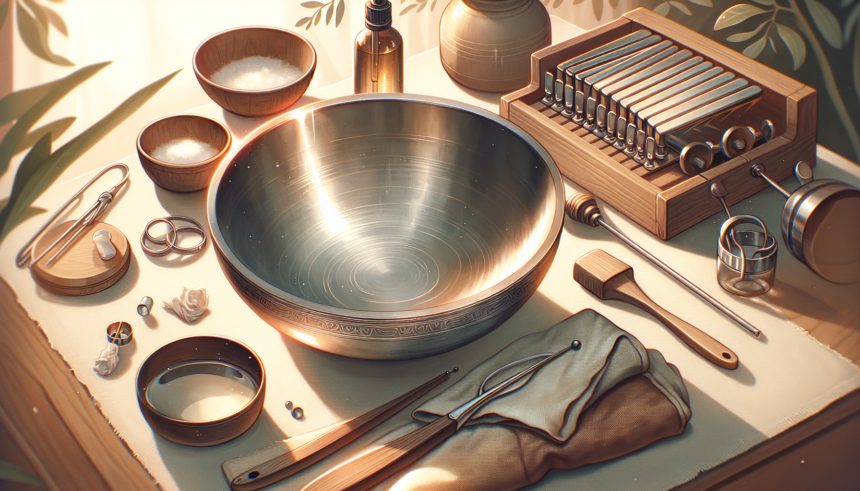The handpan, also known as a pantam or hang drum, is a unique and delicate musical instrument that produces ethereal sounds. Proper cleaning and maintenance are essential to maintain the instrument’s quality and prolong its life. This article will guide you through the steps to properly clean and care for your handpan, ensuring it remains in optimal condition for years to come.
Understanding Your Handpan’s Material
Your handpan may be made from various materials, such as nitrided steel, stainless steel, or raw steel. Each material requires specific cleaning and care techniques to prevent rust, corrosion, and other forms of damage:
- Nitrided steel: Often the most common handpan material, it has undergone a heat treatment process that makes it more resistant to rust and corrosion.
- Stainless steel: This material is highly resistant to rust and corrosion, making it relatively low maintenance.
- Raw steel: Susceptible to rust and corrosion, it requires more frequent and careful maintenance.
General Cleaning Steps
Regardless of the material, follow these general cleaning steps to keep your handpan clean and in good condition:
- Wash your hands: Before handling your handpan, always wash and dry your hands thoroughly to remove oils and contaminants that can tarnish the instrument’s surface.
- Wipe down after each use: Use a soft, dry microfiber cloth to gently wipe the surface, removing fingerprints, sweat, and dust.
- Store in a dry place: Keep your handpan in a humidity-controlled environment to prevent rust and corrosion.
Deep Cleaning Your Handpan
Every few months, perform a deep clean to maintain the appearance and function of your handpan:
- Use a gentle cleaner: Choose a mild, non-abrasive cleaner specifically designed for the type of material your handpan is made from. Avoid using harsh chemicals, as they can damage the surface.
- Apply the cleaner: Dampen a soft, lint-free cloth with the cleaner and gently wipe the entire surface of the handpan. Be sure to reach all crevices and edges.
- Rinse thoroughly: Use a separate damp cloth to wipe away any remaining cleaner, ensuring no residue is left on the instrument.
- Dry completely: After cleaning, use a dry microfiber cloth to thoroughly dry your handpan. Leaving moisture on the surface can lead to rust, especially for raw steel handpans.
Maintaining a Protective Coating
For additional protection against rust and corrosion, apply a protective coating regularly:
- Choose the right product: Look for oils or waxes specifically designed for handpans. Popular choices include Phoenix Oil, Froglube, or Ballistol.
- Apply the protective coating: Pour a small amount of oil or wax onto a clean, soft cloth. Gently rub it onto the surface of your handpan using circular motions until the entire instrument is covered.
- Buff the surface: Use a dry cloth to buff the surface, removing any excess oil or wax and ensuring an even, thin layer is left behind. Repeat this process every few weeks or months, depending on your handpan’s material and the environment in which it is stored.
Handling and Storing Your Handpan
Proper handling and storage are crucial for preventing damage and maintaining the quality of your handpan:
- Avoid extreme temperatures: Keep your handpan away from direct sunlight, heaters, and cold environments, as extreme temperatures can warp or damage the instrument.
- Use a protective case: Invest in a high-quality, padded case to protect your handpan from impacts, scratches, and dust during storage and transport.
- Store on a stable surface: Place your handpan on a stable, flat surface when not in use. Avoid placing heavy objects on top of it, as this can cause dents or damage to the instrument’s shape.
Regular Inspections
Perform regular inspections to identify any potential issues before they become serious problems:
- Check for rust and corrosion: Inspect the surface of your handpan for any signs of rust or corrosion. If you notice any, clean the affected area and apply a protective coating immediately.
- Inspect for dents and cracks: Examine the surface for any dents, cracks, or other damage that may affect the sound quality. If you find any issues, consult a professional handpan tuner or repair specialist.
- Listen for sound changes: Play your handpan regularly and listen for any changes in sound quality. If you notice any issues, it may be a sign that your instrument needs cleaning, tuning, or repair.
Conclusion
Taking the time to properly clean and care for your handpan is essential for maintaining its quality and longevity. By following these guidelines, you can ensure your instrument remains in top condition, providing you with beautiful, resonant sounds for years to come. Regular cleaning, protective coatings, proper handling and storage, and routine inspections are all vital components of effective handpan care.
FAQs
1. How often should I clean my handpan?
You should wipe down your handpan after each use with a soft, dry microfiber cloth. Perform a deep clean every few months and apply a protective coating regularly, depending on your handpan’s material and environment.
2. Can I use household cleaners on my handpan?
No, avoid using household cleaners as they can be abrasive and may damage the surface of your handpan. Use a mild cleaner specifically designed for the type of material your handpan is made from.
3. What should I do if my handpan gets rusty?
If you notice rust on your handpan, clean the affected area immediately with a damp cloth and apply a protective coating. For severe rust or damage, consult a professional handpan repair specialist.
4. How should I store my handpan when not in use?
Store your handpan in a high-quality, padded case on a stable, flat surface. Keep it away from extreme temperatures and humidity to prevent damage and corrosion.
5. How can I tell if my handpan needs tuning or repair?
Regularly play your handpan and listen for any changes in sound quality. If you notice any issues, such as dull or distorted notes, it may be a sign that your handpan needs tuning or repair by a professional specialist.





